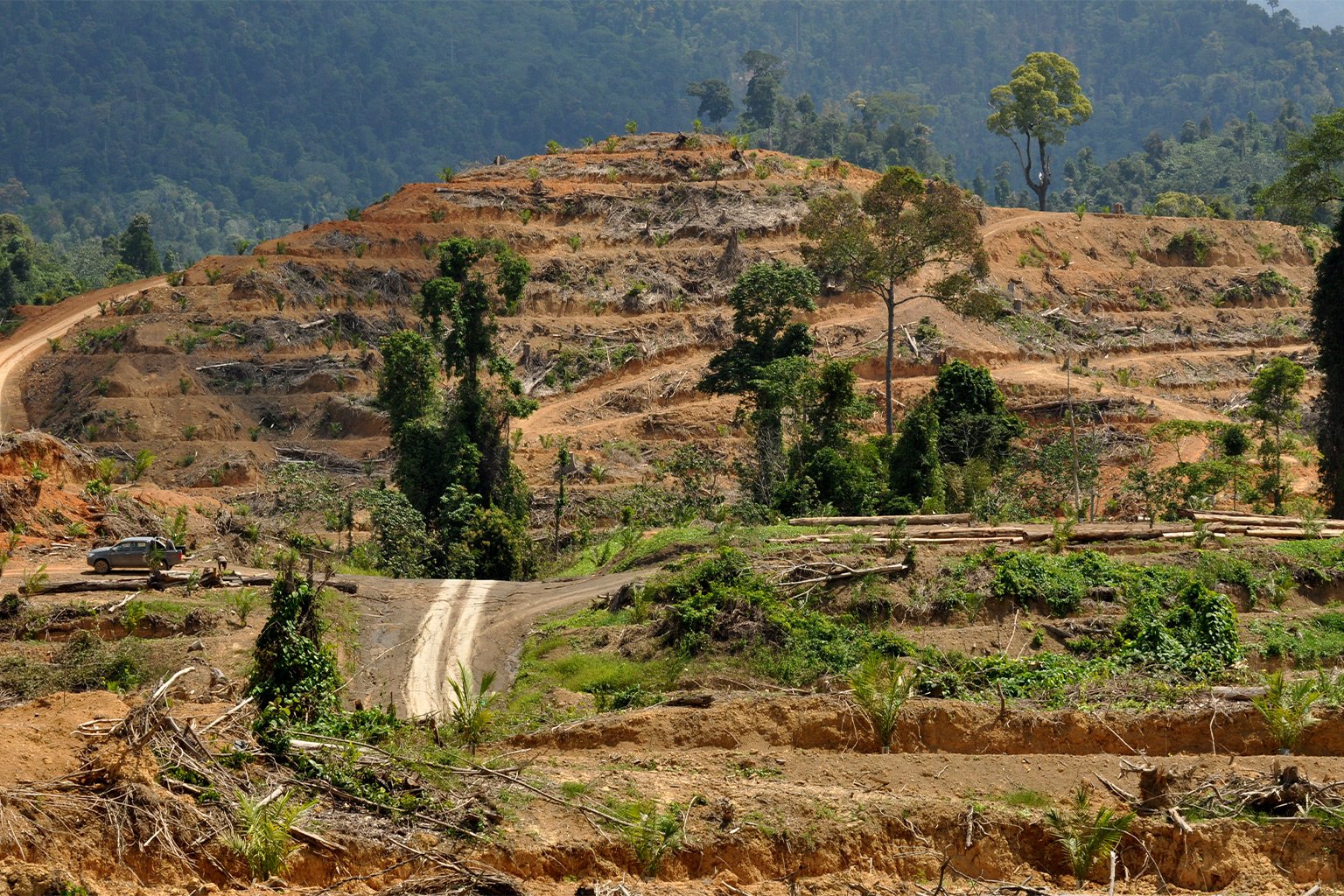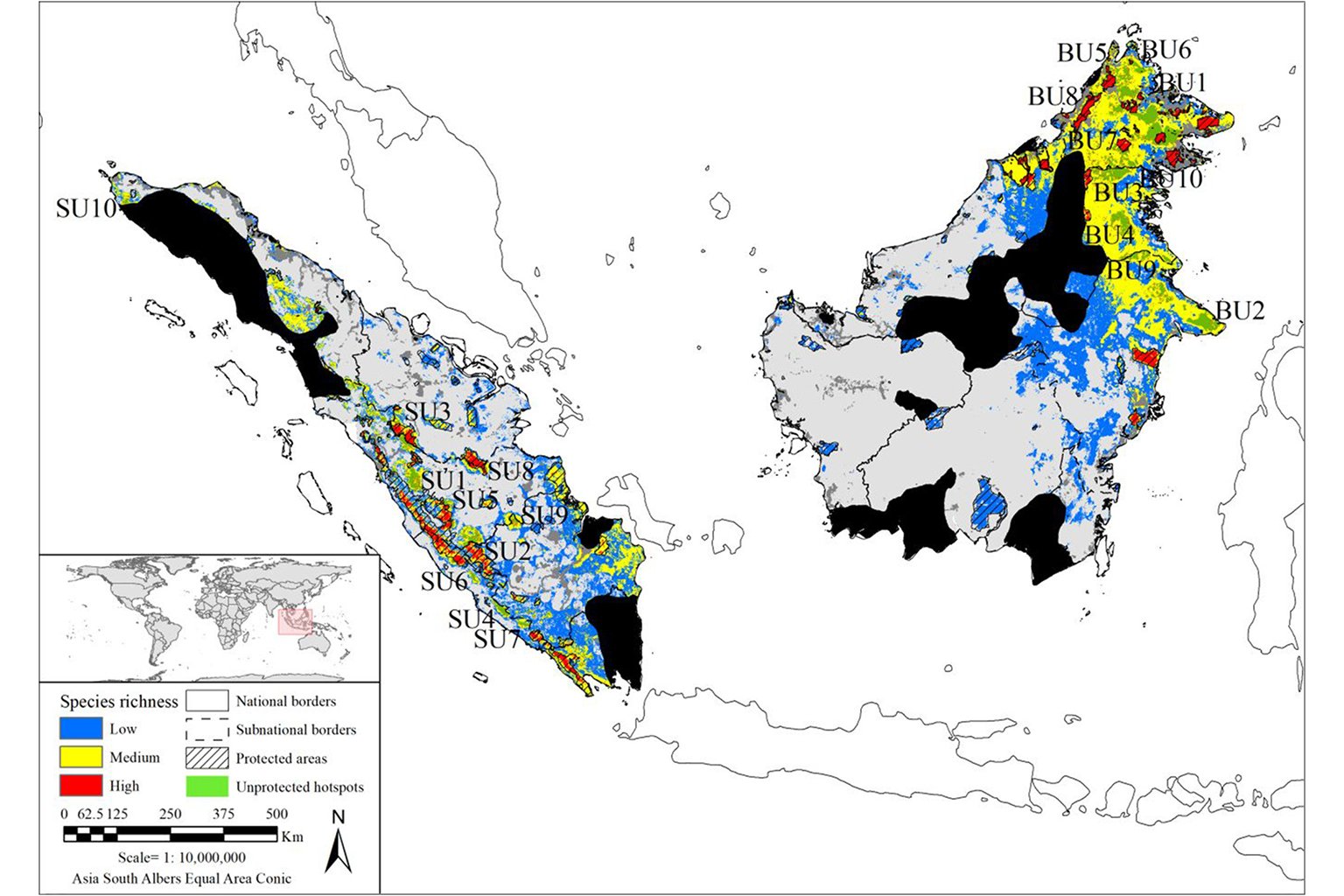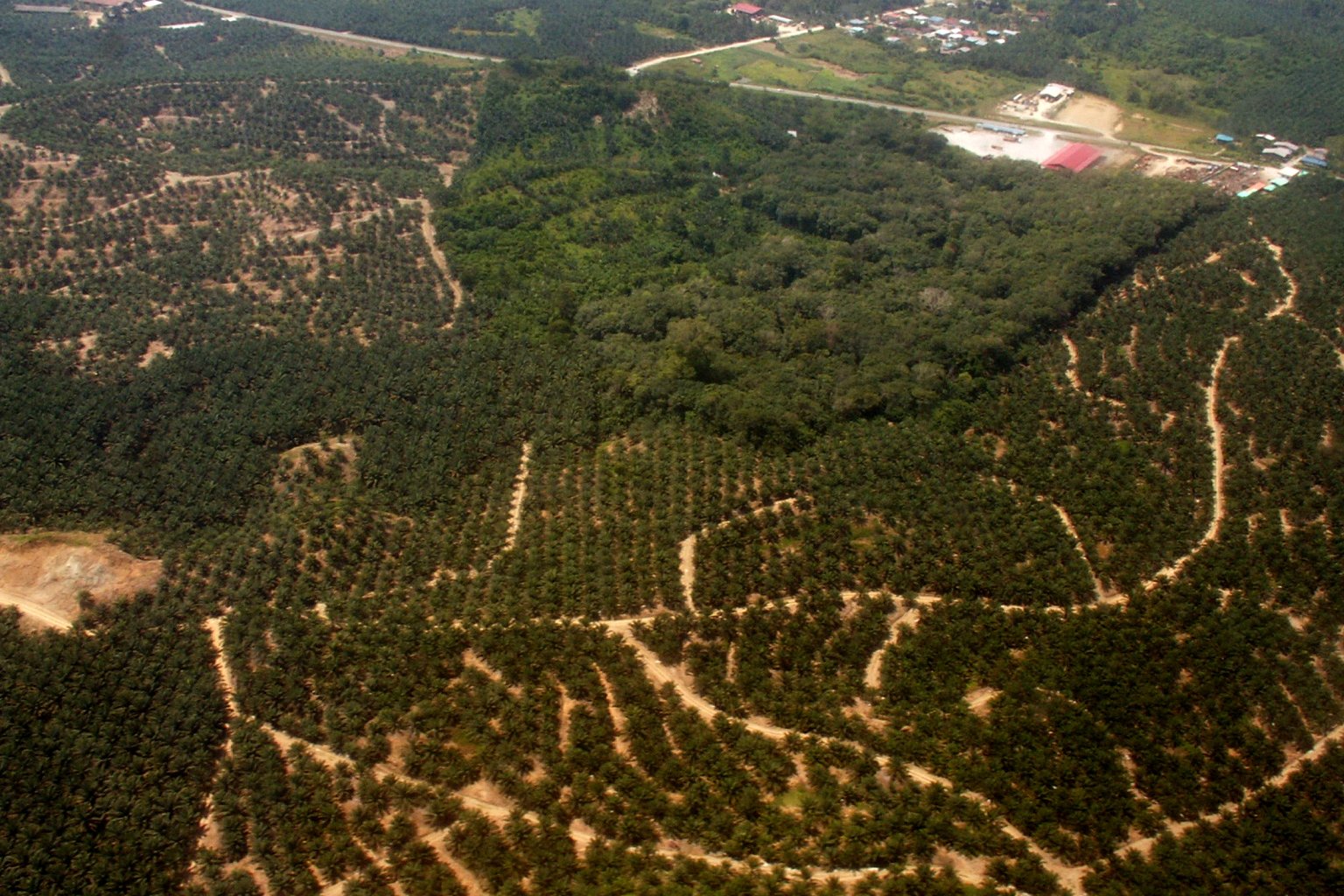- A new study published in Animal Conservation finds that most predicted biodiversity hotspots in Borneo and Sumatra fall outside formally protected areas, with only 9.2% and 18.2% of the modeled species richness located within protection zones on the respective islands.
- The researcher team conducted the largest camera-trap survey ever undertaken in Borneo and Sumatra, and used multiple criteria to determine the relationship of 70 species to the surrounding habitat and how animal communities are assembled.
- The study concluded that carnivorous mammals can be used as an umbrella species to assist in the development of holistic management plans in areas where multiple species coexist.
The Sundaland bioregion spans Borneo, Sumatra, Java, the Malay Peninsula and a myriad of smaller surrounding islands. Sundaland hosts one of the largest tracts of primary rainforest cover globally and, with it, some of the most important biodiversity hotspots in the world.
Sumatra, part of Indonesia, and Borneo, shared by Indonesia, Malaysia and Brunei, face an increasing level of threat to their biodiversity from human activity, including deforestation for oil palm and timber plantations, as well as fires for land clearing.
Between 2002 and 2019, Borneo and Sumatra alone lost the largest share of primary forest cover in the world, with 15% and 25% forest cover loss respectively. Predicted population increases in the region are only expected to exacerbate these pressures, reducing access to primary habitat for of a number of endemic and critically endangered species, such as orangutans (Pongo spp.), Sumatran rhinos (Dicerorhinos sumatrensis), as well as scores of other mammal, bird, reptile and amphibian species.
Now, a paper published in Animal Conservation in February has found that most of the predicted biodiversity hotspots in Borneo and Sumatra fall outside formal protection measures, with only 9.2% and 18.2% of the modeled species richness located within protection zones on the respective islands.
Multivariate modeling: Management for a whole community
Lead author Luca Chiaverini of the University of Oxford’s Department of Zoology told Mongabay that in reaching these findings, the research team chose to focus on multiple species and multiple habitat criteria to demonstrate the relationship between species and their environment, as well as the interspecies relationships.
“This is ultimately the main difference between our approach and most of the other species richness models,” Chiaverini said. “In [single-species] models, the suitable habitat for each species is modeled individually using the habitat factors found to be important for that one species. Not for the entire sampled biodiversity.”
In practice, this meant the researchers applied a novel multispecies and habitat suitability criteria to predict biodiversity hotspots across the Sunda Islands of Borneo and Sumatra. The paper recognized that the abundance of common species in an area is a better indicator of species richness than relying solely on one rare or threatened species. This was especially significant as conservation predictive modeling techniques have historically relied on one flagship species to advocate for the protection of a region.
Moreover, in undertaking the largest camera-trap survey ever conducted in Borneo and Sumatra, the research team used multiple criteria to determine the relationship of 70 species to the surrounding habitat and how animal communities are assembled.
Camera traps were set in 15 sampling locations in Borneo — five in the Indonesian provinces of Central and East Kalimantan and 10 in the Malaysian state of Sabah — and in seven locations across Sumatra. Species abundance was then compared against a range of criteria to assess habitat suitability for each species.
Human impacts on these potential hotspot areas were also accounted for, including population density, forest use and loss, and whether the area had been zoned for protection. The multivariate approach overall took into account the joint effects of landscape, anthropogenic, topographic and spatial factors on the simultaneous presence of different species in the sample sites.

Defining biodiversity protection outcomes
The research team also evaluated the current level of biodiversity protections, highlighting key areas where conservation actions should be expanded and prioritized. The overall species richness prediction was compared to internationally recognized species maps from the IUCN, the global conservation authority. This juxtaposition found that existing protected areas in Borneo and Sumatra are in relatively poor locations and of insufficient size and extent to protect the main biodiversity hotspots.
Chiaverini said this multispecies modeling approach has the capacity to guide the definition of new protection zones, with the paper providing recommendations for priority areas based on the species found there and distinct ecological features.
“This study could be an important tool to prioritize areas to protect in Borneo and Sumatra based on their biodiversity; based on something as simple as the number of sampled species they host,” Chiaverini said.
Northern Borneo, specifically the Malaysian state of Sabah, the Indonesian provinces of North and East Kalimantan, and Brunei, were predicted to host the highest species richness in Borneo. While only a few protected areas occur in this region, their critical importance is made clear in the study. In Sumatra, the western mountainous regions presented the highest levels of species richness. A separate study cited in the paper and published in 2009 also found these same regions to be critical hotspots for botanical species richness.
But critically, Sabah was found to host the highest levels of species richness outside of protected areas, with more than 5,500 square kilometers (2,100 square miles) of unprotected lands that were identified as biodiversity hotspots.

Umbrella species
While the study was conducted within a multivariate context, the team considered that it was still important to consider the individual preferences of sampled species. Part of this included investigating the role that different species play as potential key indicators of high biodiversity.
The analysis revealed that the presence of the lesser mouse-deer (Tragulus kanchil) and Sunda leopard cat (Prionailurus javanensis) were the best indicators of biodiversity in both Borneo and Sumatra. In addition, to the surprise of the research team, rat species were the second-best indicator in both islands.
Ultimately, the research team says, mammalian carnivores such as these can be used as an “umbrella” species to assist in the development of holistic management plans. When making conservation decisions, an umbrella species is selected for protection because it indirectly protects many of the other species that are found in its surrounding habitat and ecological community.
“Conservation of species and of biodiversity is based on choices and compromises: on one hand there is the possibility of preserving the totality of the biodiversity and on the other hand completely neglecting the unique biodiversity of this region. Clearly, neither is applicable nor desirable, and the trade-off lingers somewhere between these two extremes,” Chiaverini said.
Mongabay spoke to George Olah, honorary lecturer at the Australian National University’s Fenner School of Environment and Society, about the application of the study in the Sunda Islands and the potential benefits that could be derived from the paper’s findings.
“Conservationists often use the image of a single flagship species when lobbying for habitat protection. But with our ever-better understanding of the interactions in biological communities, I totally agree with the authors that we need a paradigm shift to multiple species conservation approaches (or multiple flagship species),” Olah said.
“When government funds and time for habitat protection are so restricted, I find it especially important to use modeling studies like this to highlight biodiversity hotspots most in need for conservation,” Olah added.

Banner image: A leopard cat. Image by Mike Prince via Wikimedia Commons (CC BY 2.0).
Citations:
Chiaverini, L., Macdonald, D. W., Bothwell, H. M., Hearn, A. J., Cheyne, S. M., Haidir, I., … Cushman, S. A. (2022). Multi-scale, multivariate community models improve designation of biodiversity hotspots in the Sunda Islands. Animal Conservation. doi:10.1111/acv.12771
Raes, N., Roos, M. C., Slik, J. W. F., van Loon, E. E., & ter Steege, H. (2009). Botanical richness and endemicity patterns of Borneo derived from species distribution models. Ecography, 32, 180-192. doi:10.1111/j.1600-0587.2009.05800.x












